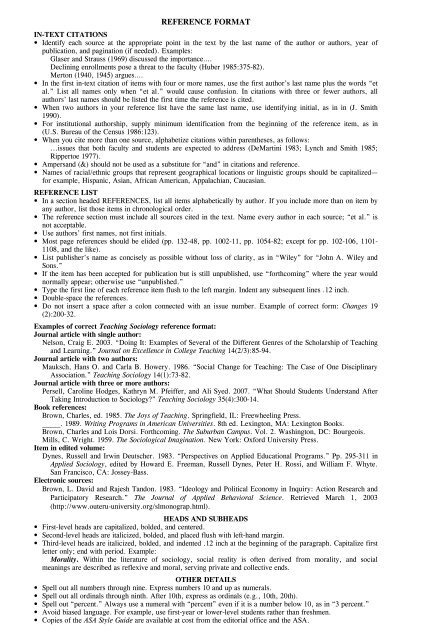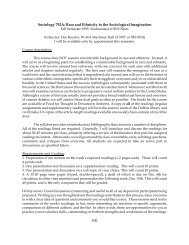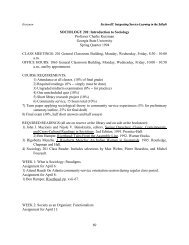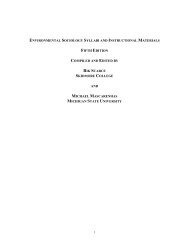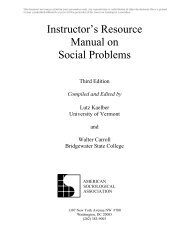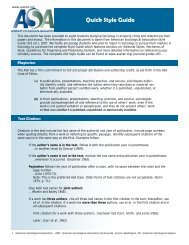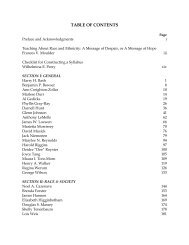3337 TS Vol36_2_APRIL 08 - American Sociological Association
3337 TS Vol36_2_APRIL 08 - American Sociological Association
3337 TS Vol36_2_APRIL 08 - American Sociological Association
Create successful ePaper yourself
Turn your PDF publications into a flip-book with our unique Google optimized e-Paper software.
REFERENCE FORMAT<br />
IN-TEXT CITATIONS<br />
• Identify each source at the appropriate point in the text by the last name of the author or authors, year of<br />
publication, and pagination (if needed). Examples:<br />
Glaser and Strauss (1969) discussed the importance….<br />
Declining enrollments pose a threat to the faculty (Huber 1985:375-82).<br />
Merton (1940, 1945) argues….<br />
• In the first in-text citation of items with four or more names, use the first author’s last name plus the words “et<br />
al.” List all names only when “et al.” would cause confusion. In citations with three or fewer authors, all<br />
authors’ last names should be listed the first time the reference is cited.<br />
• When two authors in your reference list have the same last name, use identifying initial, as in in (J. Smith<br />
1990).<br />
• For institutional authorship, supply minimum identification from the beginning of the reference item, as in<br />
(U.S. Bureau of the Census 1986:123).<br />
• When you cite more than one source, alphabetize citations within parentheses, as follows:<br />
...issues that both faculty and students are expected to address (DeMartini 1983; Lynch and Smith 1985;<br />
Rippertoe 1977).<br />
• Ampersand (&) should not be used as a substitute for “and” in citations and reference.<br />
• Names of racial/ethnic groups that represent geographical locations or linguistic groups should be capitalized—<br />
for example, Hispanic, Asian, African <strong>American</strong>, Appalachian, Caucasian.<br />
REFERENCE LIST<br />
• In a section headed REFERENCES, list all items alphabetically by author. If you include more than on item by<br />
any author, list those items in chronological order.<br />
• The reference section must include all sources cited in the text. Name every author in each source; “et al.” is<br />
not acceptable.<br />
• Use authors’ first names, not first initials.<br />
• Most page references should be elided (pp. 132-48, pp. 1002-11, pp. 1054-82; except for pp. 102-106, 1101-<br />
11<strong>08</strong>, and the like).<br />
• List publisher’s name as concisely as possible without loss of clarity, as in “Wiley” for “John A. Wiley and<br />
Sons.”<br />
• If the item has been accepted for publication but is still unpublished, use “forthcoming” where the year would<br />
normally appear; otherwise use “unpublished.”<br />
• Type the first line of each reference item flush to the left margin. Indent any subsequent lines .12 inch.<br />
• Double-space the references.<br />
• Do not insert a space after a colon connected with an issue number. Example of correct form: Changes 19<br />
(2):200-32.<br />
Examples of correct Teaching Sociology reference format:<br />
Journal article with single author:<br />
Nelson, Craig E. 2003. “Doing It: Examples of Several of the Different Genres of the Scholarship of Teaching<br />
and Learning.” Journal on Excellence in College Teaching 14(2/3):85-94.<br />
Journal article with two authors:<br />
Mauksch, Hans O. and Carla B. Howery. 1986. “Social Change for Teaching: The Case of One Disciplinary<br />
<strong>Association</strong>.” Teaching Sociology 14(1):73-82.<br />
Journal article with three or more authors:<br />
Persell, Caroline Hodges, Kathryn M. Pfeiffer, and Ali Syed. 2007. “What Should Students Understand After<br />
Taking Introduction to Sociology?” Teaching Sociology 35(4):300-14.<br />
Book references:<br />
Brown, Charles, ed. 1985. The Joys of Teaching. Springfield, IL: Freewheeling Press.<br />
_____. 1989. Writing Programs in <strong>American</strong> Universities. 8th ed. Lexington, MA: Lexington Books.<br />
Brown, Charles and Lois Dorsi. Forthcoming. The Suburban Campus. Vol. 2. Washington, DC: Bourgeois.<br />
Mills, C. Wright. 1959. The <strong>Sociological</strong> Imagination. New York: Oxford University Press.<br />
Item in edited volume:<br />
Dynes, Russell and Irwin Deutscher. 1983. “Perspectives on Applied Educational Programs.” Pp. 295-311 in<br />
Applied Sociology, edited by Howard E. Freeman, Russell Dynes, Peter H. Rossi, and William F. Whyte.<br />
San Francisco, CA: Jossey-Bass.<br />
Electronic sources:<br />
Brown, L. David and Rajesh Tandon. 1983. “Ideology and Political Economy in Inquiry: Action Research and<br />
Participatory Research.” The Journal of Applied Behavioral Science. Retrieved March 1, 2003<br />
(http://www.outeru-university.org/slmonograp.html).<br />
HEADS AND SUBHEADS<br />
• First-level heads are capitalized, bolded, and centered.<br />
• Second-level heads are italicized, bolded, and placed flush with left-hand margin.<br />
• Third-level heads are italicized, bolded, and indented .12 inch at the beginning of the paragraph. Capitalize first<br />
letter only; end with period. Example:<br />
Morality. Within the literature of sociology, social reality is often derived from morality, and social<br />
meanings are described as reflexive and moral, serving private and collective ends.<br />
OTHER DETAILS<br />
• Spell out all numbers through nine. Express numbers 10 and up as numerals.<br />
• Spell out all ordinals through ninth. After 10th, express as ordinals (e.g., 10th, 20th).<br />
• Spell out “percent.” Always use a numeral with “percent” even if it is a number below 10, as in “3 percent.”<br />
• Avoid biased language. For example, use first-year or lower-level students rather than freshmen.<br />
• Copies of the ASA Style Guide are available at cost from the editorial office and the ASA.


